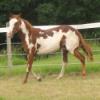Grey- Fleabitten vs dappled
Forums
Re: Grey- Fleabitten vs dappled
Both are stages in the greying process. A horse usually starts to develop dapples once it is at the darkest stage of the greying. Flea-bites are an end stage, though not all horses develop them. If I recall correctly, heterozygous horses are more likely to develop flea-bites.
AA>Aa>aa in protection against melanoma development.
Re: Grey- Fleabitten vs dappled
Yep, the pretty steel grey could go through both a dapple phase [i]and[/i] a fleabitten phase.
My Teddy as a four (?) year old:
[img]http://img.photobucket.com/albums/v338/…]
a few years later:
[img]http://img.photobucket.com/albums/v338/…]
age ten:
[img]http://img.photobucket.com/albums/v338/…]
age fifteen:
[img]http://img.photobucket.com/albums/v338/…]
Re: Grey- Fleabitten vs dappled
Almost 2 years ago I wrote someone who'd written about, or referenced the hetero/flea bitten theory. She just replied to me the other day. It's not enlightening, but I thought it interesting coincidence that she just responded:
From: A>
To: Alecia Albury <>
Sent: Thursday, March 19, 2009 9:43:04 PM
Subject: Re: flea bitten/bloodmarks
Hi Alecia,
That's a very interesting question! I'm not sure if any studies have been done, please let me know what you find out.
I know our fleabitten gray is Gg, but I have not done a poll or anything like that. I may actually look into doing some type of survey or poll...
Have you tried Sponenberg's new book?
thanks,
Annamaria
http://www.ultimatehorsesite.com" onclick="window.open(this.href);return false;
On Sat, May 12, 2007 at 3:47 PM, Alecia Albury <> wrote:
Hello,
I am looking for studies on flea bitten grays. You state that flea bitten gray is a “recessive form of gray” on http://www.ultimatehorsesite.com/colors…" onclick="window.open(this.href);return false;
Can you give me your reference for that? Or do you happen to know if any studies have been actually done that show that zygosity for gray affects flea bites? (what I keep seeing is that GG's do not get the flea bites and Gg's do) I know Sponenburg wrote it was not proven, but wondered if it had or had not been looked at since.....
Thank you very much for your time,
Alecia Albury
Re: Grey- Fleabitten vs dappled
[quote]So ACC doesnt forget...can you tell us about the interaction between gray on chestnuts as far as agouti goes?? Does the chance of melanomas still go AA > Aa > aa on chestnuts??
So ACC doesnt forget...can you tell us about the interaction between gray on chestnuts as far as agouti goes?? Does the chance of melanomas still go AA > Aa > aa on chestnuts??
[/quote]
The gray paper stated that statistically speaking, horses that were "aa" were more likely to develop melanomas. That included both blacks and chestnuts. It didn't say anything about AA versus Aa.
Re: Grey- Fleabitten vs dappled
Here is a newborn picture of the filly I'm interested in (obviously she was black at birth, not bay or brown like I had thought):
[img]http://img.photobucket.com/albums/v128/…]
As a 2 year old she was mostly black still but you could see she was going grey (mostly just the tip of her tail was grey).
Here is a picture of her now, at 4 years old:
[img]http://img.photobucket.com/albums/v128/…]
[img]http://img.photobucket.com/albums/v128/…]
Thoughts about her greying progression?
So she must be aa since she was born black....That nutses things up a bit... anyone have any experience making a decision about a horse based on something like them being aa and grey and therefore wondering if they will get melanomas...and where/when they will get them? :sad
Re: Grey- Fleabitten vs dappled
I have cared for a little welsh pony that is now 29 years old and she is dotted all over her body with melanomas, you can see a few below the skin and under her tail in the gential area, and most definately she has them in her intestine, but always been super careful with her diet to keep things flowing carefully , she did about 2 yrs ago now and a bout of colic that we thought would kill her, but she is still kickin. I think it is a luck of the draw if they become fatal sooner then need be, she has been lucky and survived a long life with them, but if one of the intestine ones got oversized she could have very well twisted and died .She may come live the rest of her days with me in NC soon.
Re: Grey- Fleabitten vs dappled
Heather, how do you know the pony has them in her intestine?
I have three greys, age 15, 16, and 21 and only the 15 year old (the Lipi x TB mare) has melanomas so far. The interesting thing is that they have shrunk considerably since I got her. Are they diet or stress related?
Re: Grey- Fleabitten vs dappled
I'm jealous, Sara! I wish I had a full grey transition...all I have is this:
age 7:
[img]http://i7.photobucket.com/albums/y291/P…]
http://i7.photobucket.com/albums/y291/P…" onclick="window.open(this.href);return false;
age 8:
http://i7.photobucket.com/albums/y291/P…" onclick="window.open(this.href);return false;
http://i46.photobucket.com/albums/f122/…" onclick="window.open(this.href);return false;
age 9:
http://i46.photobucket.com/albums/f122/…" onclick="window.open(this.href);return false;
age 10:
http://i7.photobucket.com/albums/y291/P…" onclick="window.open(this.href);return false;
http://i46.photobucket.com/albums/f122/…" onclick="window.open(this.href);return false;
age 11:
http://i46.photobucket.com/albums/f122/…" onclick="window.open(this.href);return false;
age 12:
[img]http://i7.photobucket.com/albums/y291/P…]
Re: Grey- Fleabitten vs dappled
[quote="lipigirl"]Yes the flebites come much later in the greying process.
The theory that Flebitten are Hetrozygous can't be true almost most Lipizzaners get fleabites !!! :roll:[/quote]
Maybe it was the ones that stay flea-bitten and don't progress to white that are heterozygous? There was definitely a connection between the two that I remember . Anyone remember what the link was to the paper?
Diane
Re: Grey- Fleabitten vs dappled
Here's her pedigree-











Re: Grey- Fleabitten vs dappled
I was thinking fleabitten happens in the "white" stage of the grey? So that like a dapple grey can turn into fleabitten?